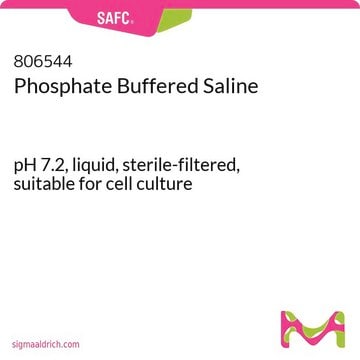D8662
Dulbecco′s Phosphate Buffered Saline
Liquid, with MgCl₂ and CaCl₂, sterile-filtered, suitable for cell culture
Synonym(s):
DPBS
About This Item
Recommended Products
product name
Dulbecco′s Phosphate Buffered Saline, With MgCl2 and CaCl2, liquid, sterile-filtered, suitable for cell culture
Quality Level
sterility
sterile-filtered
form
liquid
technique(s)
cell culture | mammalian: suitable
impurities
endotoxin, tested
components
sodium pyruvate: no
glucose: no (Dextro)
shipped in
ambient
storage temp.
2-8°C
Looking for similar products? Visit Product Comparison Guide
General description
Application
- as a component of the reaction mixture for the fluoro-labeling reaction of pro-nerve growth factor (proNGF)-YBBR
- to wash and equilibrate the cells post transepithelial electrical resistance (TEER) measurement of Caco-2BBe cells
- to wash cells for protein isolation
- as a component of the reaction mixture for the fluoro-labeling reaction of pro-nerve growth factor (proNGF)-YBBR
- to wash and equilibrate the cells post transepithelial electrical resistance (TEER) measurement of Caco-2BBe cells
- to wash cells for protein isolation
Biochem/physiol Actions
- provides cells with water and certain bulk inorganic ions essential for normal cell metabolism
- serves as an irrigating, transporting, and diluting fluid while maintaining intra- and extracellular osmotic balance
- when combined with a carbohydrate, such as glucose, provides the principal energy source for cell metabolism
- provides a buffering system to maintain the medium within the physiological pH range
related product
Storage Class Code
12 - Non Combustible Liquids
WGK
nwg
Flash Point(F)
Not applicable
Flash Point(C)
Not applicable
Certificates of Analysis (COA)
Search for Certificates of Analysis (COA) by entering the products Lot/Batch Number. Lot and Batch Numbers can be found on a product’s label following the words ‘Lot’ or ‘Batch’.
Already Own This Product?
Find documentation for the products that you have recently purchased in the Document Library.
Customers Also Viewed
Our team of scientists has experience in all areas of research including Life Science, Material Science, Chemical Synthesis, Chromatography, Analytical and many others.
Contact Technical Service







